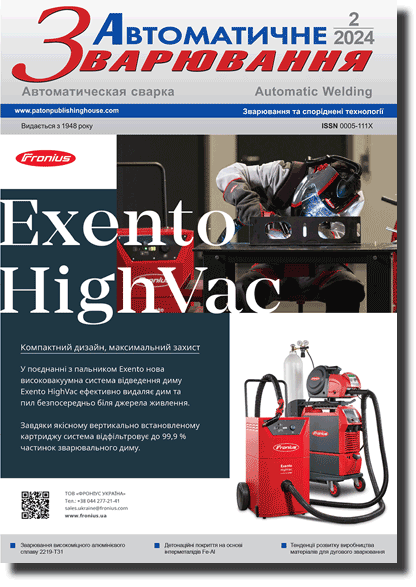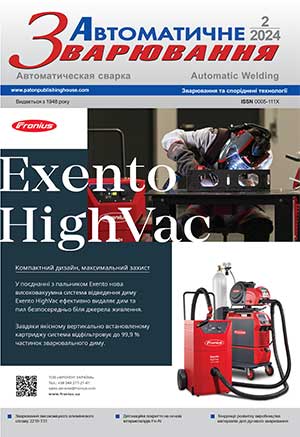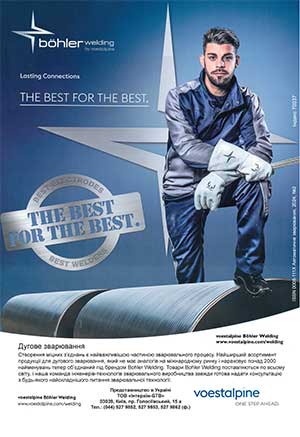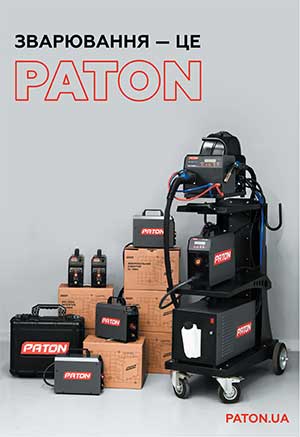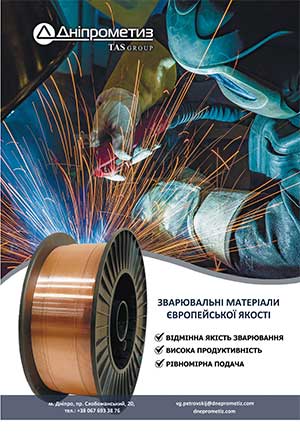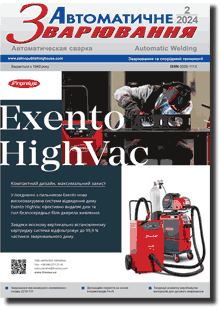
Avtomaticheskaya Svarka (Automatic Welding), #2, 2024, pp. 12-15
This paper describes the method of shaping the product using 3D technology by means of applying arc heating and consumable material – a wire with a diameter of 1.2 mm. The aim of the work is to study the structure and mechanical properties of the product manufactured using additive 3D technology. Each deposited layer consists of three separate beads: two lateral ones, which provide the set contours of the layer, and one middle one, which fills the space between the two lateral ones. Electric arc surfacing was carried out with the help of a welding robot. The use of a robot made it possible to control the time between layer depositions, thereby controlling grain growth. Also, the use of a robot makes it possible to reproduce a set part as accurately as possible according to a pre-calculated and designed model with a minimum error of repetition of the torch movement of ±0.03 mm. As a result, the structure and mechanical properties of the deposited product were investigated. It is shown that the product manufactured according to the presented technology has a fine-grained ferrite-pearlite structure; the grain size ranges from 7 to 10 numbers. The mechanical properties along and across the deposited layers were studied. The indices practically do not differ. A comparison of their values with normative ones showed that they exceeded normative values by 10–50%. 14 Ref., 3 Tabl., 4 Fig.
Keywords: 3D technology, 09G2S steel, structure, electric arc, wire, additive technologies, electric arc surfacing, welding robot
Received: 15.11.2023
Received in revised form: 26.02.2024
Accepted: 18.03.2024
2. Dongaonkar, A.V., Metkar, R.M. (2018) Reconstruction of Damaged Parts by Integration Reverse Engineering (RE) and Rapid Prototyping (RP). 3D Printing and Additive Manufacturing Technologies, 159-171. https://doi.org/10.1007/978-981-13-0305-0_14
3. (2020) ALL3DP. Metal 3d Printer Buyer's Guide. https://all- 3dp.com/1/3d-metal-3d-printer-metal-3d-printing
4. Zhukov, V.V., Grigorenko, G.M., Shapovalov, V.A. (2016) Additive manufacturing of metal products (Review). The Paton Welding J., 5-6, 148-153. https://doi.org/10.15407/tpwj2016.06.24
5. Hemnath Anandan Kumar, Senthilkumaran Kumaraguru (2018) Distortion in Metal Additive Manufactured Parts. 3D Printing and Additive Manufacturing Technologies, 281-295. https://doi.org/10.1007/978-981-13-0305-0_24
6. Kostin, V.A., Grigorenko, G.M. (2017) Peculiarities of formation of 3D structure of S460M steel product in additive metallurgical technology. Suchasna Elektrometal., 3 (128), 33-42 [in Russian]. https://doi.org/10.15407/sem2017.03.06
7. Doroshenko, V.S. (2014) 3D-technologies for manufacturing castings as the examples of additive production. Metall i Litiyo Ukrainy, 12, 4-9 [in Russian].
8. Shapovalov,V.A., Grigorenko, G.M. (2015) Suppression of liquation processes in large ingots. Sovrem. Elektrometall., 1, 26-30 [in Russian]. https://doi.org/10.15407/sem2015.01.05
9. Shapovalov, V.A. (2016) Application of welding technologies for suppression of liquation in large ingots. The Paton Welding J., 5-6(753), 162-165. https://doi.org/10.15407/as2016.06.26
10. Shapovalov, E.V., Dolinenko, V.V., Kolyada, V.A. et al. (2016) Application of robotic and mechanized welding under disturbing factor conditions. The Paton Welding J., 7, 42-46. https://doi.org/10.15407/tpwj2016.07.08
11. Yadav, Anshul et al. (2019) Thermal Transport Phenomena in Multi-layer Deposition Using Arc Welding Process. 3D Printing and Additive Manufacturing Technologies, 15-27. https://doi.org/10.1007/978-981-13-0305-0_2
12. International Standards Office (2019) ISO 643: Steels. Micrographic determination of the apparent grain size. ISO, Geneva, Switzerland.
13. ASTM E112-13: Standard Test Methods for Determining Average Grain Size. ASTM, West Conshohocken, Pennsylvania, U.S.
14. ASTM E8: Standard Test Methods for Tension Testing of Metallic Materials. ASTM, West Conshohocken, Pennsylvania, U.S.
Metal products manufactured with arc 3D robotic technology
Automatic Welding №02 2024 p.12-15
The cost of article: 150 UAH,16 $,15 €. (one article)
AS = «Automatic Welding» - 6 issues per year;
TPWJ = «PATON WELDING JOURNAL» - 12 issues per year;
SEM = «Electrometallurgy Today» - 4 issues per year;
TDNK = «Technical Diagnostics and Non-Destructive Testing» - 4 issues per year.
| 2024 №02 (01) |
DOI of Article 10.37434/as2024.02.02 |
2024 №02 (03) |

Avtomaticheskaya Svarka (Automatic Welding), #2, 2024, pp. 12-15
Metal products manufactured with arc 3D robotic technology
E.V. Shapovalov, V.O. Kolyada, A.S. Novodranov, A.M. Mangold, D.D. Topchev
E.O. Paton Electric Welding Institute of the NAS of Ukraine 11 Kazymyr Malevych Str., 03150, Kyiv, Ukraine. E-mail: office@paton.kiev.uaThis paper describes the method of shaping the product using 3D technology by means of applying arc heating and consumable material – a wire with a diameter of 1.2 mm. The aim of the work is to study the structure and mechanical properties of the product manufactured using additive 3D technology. Each deposited layer consists of three separate beads: two lateral ones, which provide the set contours of the layer, and one middle one, which fills the space between the two lateral ones. Electric arc surfacing was carried out with the help of a welding robot. The use of a robot made it possible to control the time between layer depositions, thereby controlling grain growth. Also, the use of a robot makes it possible to reproduce a set part as accurately as possible according to a pre-calculated and designed model with a minimum error of repetition of the torch movement of ±0.03 mm. As a result, the structure and mechanical properties of the deposited product were investigated. It is shown that the product manufactured according to the presented technology has a fine-grained ferrite-pearlite structure; the grain size ranges from 7 to 10 numbers. The mechanical properties along and across the deposited layers were studied. The indices practically do not differ. A comparison of their values with normative ones showed that they exceeded normative values by 10–50%. 14 Ref., 3 Tabl., 4 Fig.
Keywords: 3D technology, 09G2S steel, structure, electric arc, wire, additive technologies, electric arc surfacing, welding robot
Received: 15.11.2023
Received in revised form: 26.02.2024
Accepted: 18.03.2024
References
1. ASTM-International, ASTM Standard F2792-12 (2012) Standard Terminology for Additive Manufacturing Technologies.2. Dongaonkar, A.V., Metkar, R.M. (2018) Reconstruction of Damaged Parts by Integration Reverse Engineering (RE) and Rapid Prototyping (RP). 3D Printing and Additive Manufacturing Technologies, 159-171. https://doi.org/10.1007/978-981-13-0305-0_14
3. (2020) ALL3DP. Metal 3d Printer Buyer's Guide. https://all- 3dp.com/1/3d-metal-3d-printer-metal-3d-printing
4. Zhukov, V.V., Grigorenko, G.M., Shapovalov, V.A. (2016) Additive manufacturing of metal products (Review). The Paton Welding J., 5-6, 148-153. https://doi.org/10.15407/tpwj2016.06.24
5. Hemnath Anandan Kumar, Senthilkumaran Kumaraguru (2018) Distortion in Metal Additive Manufactured Parts. 3D Printing and Additive Manufacturing Technologies, 281-295. https://doi.org/10.1007/978-981-13-0305-0_24
6. Kostin, V.A., Grigorenko, G.M. (2017) Peculiarities of formation of 3D structure of S460M steel product in additive metallurgical technology. Suchasna Elektrometal., 3 (128), 33-42 [in Russian]. https://doi.org/10.15407/sem2017.03.06
7. Doroshenko, V.S. (2014) 3D-technologies for manufacturing castings as the examples of additive production. Metall i Litiyo Ukrainy, 12, 4-9 [in Russian].
8. Shapovalov,V.A., Grigorenko, G.M. (2015) Suppression of liquation processes in large ingots. Sovrem. Elektrometall., 1, 26-30 [in Russian]. https://doi.org/10.15407/sem2015.01.05
9. Shapovalov, V.A. (2016) Application of welding technologies for suppression of liquation in large ingots. The Paton Welding J., 5-6(753), 162-165. https://doi.org/10.15407/as2016.06.26
10. Shapovalov, E.V., Dolinenko, V.V., Kolyada, V.A. et al. (2016) Application of robotic and mechanized welding under disturbing factor conditions. The Paton Welding J., 7, 42-46. https://doi.org/10.15407/tpwj2016.07.08
11. Yadav, Anshul et al. (2019) Thermal Transport Phenomena in Multi-layer Deposition Using Arc Welding Process. 3D Printing and Additive Manufacturing Technologies, 15-27. https://doi.org/10.1007/978-981-13-0305-0_2
12. International Standards Office (2019) ISO 643: Steels. Micrographic determination of the apparent grain size. ISO, Geneva, Switzerland.
13. ASTM E112-13: Standard Test Methods for Determining Average Grain Size. ASTM, West Conshohocken, Pennsylvania, U.S.
14. ASTM E8: Standard Test Methods for Tension Testing of Metallic Materials. ASTM, West Conshohocken, Pennsylvania, U.S.
Advertising in this issue:
To order the electronic version of the paper:
E.V. Shapovalov, V.O. Kolyada, A.S. Novodranov, A.M. Mangold, D.D. TopchevMetal products manufactured with arc 3D robotic technology
Automatic Welding №02 2024 p.12-15
The cost of article: 150 UAH,16 $,15 €. (one article)
fill in the form below:
The cost of subscription/purchase order journals or individual articles
| Journal/Currency | Annual Set | 1 issue printed |
1 issue |
one article |
| AS/UAH | 1800 UAH | 300 UAH | 300 UAH | 150 UAH |
| AS/USD | 192 $ | 32 $ | 26 $ | 16 $ |
| AS/EUR | 180 € | 30 € | 25 € | 15 € |
| TPWJ/UAH | 7200 UAH | 600 UAH | 600 UAH | 280 UAH |
| TPWJ/USD | 384 $ | 32 $ | 26 $ | 16 $ |
| TPWJ/EUR | 360 € | 30 € | 25 € | 15 € |
| SEM/UAH | 1200 UAH | 300 UAH | 300 UAH | 150 UAH |
| SEM/USD | 128 $ | 32 $ | 26 $ | 16 $ |
| SEM/EUR | 120 € | 30 € | 25 € | 15 € |
| TDNK/UAH | 1200 UAH | 300 UAH | 300 UAH | 150 UAH |
| TDNK/USD | 128 $ | 32 $ | 26 $ | 16 $ |
| TDNK/EUR | 120 € | 30 € | 25 € | 15 € |
AS = «Automatic Welding» - 6 issues per year;
TPWJ = «PATON WELDING JOURNAL» - 12 issues per year;
SEM = «Electrometallurgy Today» - 4 issues per year;
TDNK = «Technical Diagnostics and Non-Destructive Testing» - 4 issues per year.





